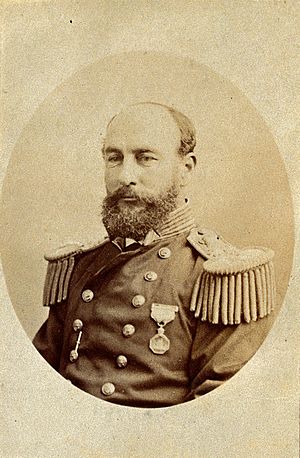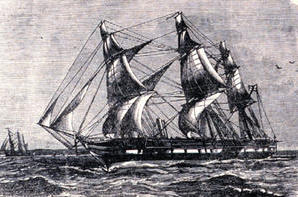George Nares facts for kids
Quick facts for kids
Sir George Nares
|
|
|---|---|
 |
|
| Birth name | George Strong Nares |
| Born | 24 April 1831 Llansenseld, UK |
| Died | 15 January 1915 (aged 83) Kingston upon Thames, UK |
| Allegiance | |
| Branch | |
| Service years | 1845–1886 |
| Rank | Vice-Admiral |
| Served on |
|
| Commands held |
|
| Expeditions | |
| Awards |
|
Vice-Admiral Sir George Strong Nares (born April 24, 1831 – died January 15, 1915) was a brave officer in the Royal Navy and a famous Arctic explorer. He led two very important expeditions: the Challenger Expedition and the British Arctic Expedition. People admired him for his strong leadership and his scientific approach to exploring. Later in his life, he worked for the government and helped manage the River Mersey.
Contents
A Life of Exploration and Discovery
George Nares was born on April 24, 1831, in a place called Llansenseld, near Abergavenny in Monmouthshire, UK. He was the sixth child in his family. His father, William Henry Nares, was also a naval officer.
George went to the Royal Naval School in London. In 1845, when he was just 14, he joined the Royal Navy. His first ship was HMS Canopus. Later, he served on HMS Havannah in Australia. By 1852, he had passed his exams to become a lieutenant.
First Trip to the Arctic
In 1851, George Nares met Commander George Henry Richards, who would later become a top mapmaker for the Navy. Richards suggested that Nares join a search for the lost explorer Sir John Franklin. Nares joined the ship Resolute and gained valuable experience exploring the Arctic from 1852 to 1854.
Becoming a Gunnery Expert
In 1854, Nares was promoted to lieutenant. He became a specialist in gunnery, which means he was an expert in how to use and aim ship guns. He served on the battleship Conqueror in the Mediterranean Sea during the Crimean War.
Teacher and Author
Nares also spent time teaching young naval cadets. He served as a lieutenant in charge of training on Illustrious and later on Britannia. During this time, he wrote a very popular book called The Naval Cadet's Guide. This book was later renamed Seamanship and was considered the best guide for sailors of its time. In 1862, he was promoted to commander.
Mapping the Seas
From 1865, Nares commanded Salamander. This ship was used for surveying, which means carefully mapping areas. He mapped parts of the east coast of Australia, including sections of the Great Barrier Reef.
His next ship was Newport. With this ship, he mapped the Gulf of Suez after the Suez Canal opened in 1869. The Suez Canal was a new waterway connecting the Mediterranean Sea to the Red Sea, making sea travel much faster. The British Navy needed a detailed map and report before its ships could use the canal. Nares and his team carefully checked the canal, taking measurements of its depth and checking navigation. They approved the canal, as long as some improvements were finished.
Because of his excellent work in the Gulf of Suez, Nares was promoted to captain in 1869. In 1871, he commanded Shearwater. On its way to the Red Sea, this ship studied ocean currents in the Straits of Gibraltar. This work helped scientists understand how water moves in the oceans.
The Challenger Expedition
In 1872, the Royal Society of London, a group of scientists, asked the Royal Navy for a ship to explore the deep oceans. They chose Challenger for a three-year scientific journey. At that time, people knew a lot about coastlines and shallow waters, but almost nothing about the deep parts of the ocean.
The Challenger was specially equipped for this mission. It carried many tools like jars for specimens, chemical equipment, nets for catching sea creatures, thermometers, and devices to collect mud from the seafloor. It also had miles of strong rope to measure the deepest parts of the ocean.
Captain Nares was chosen to lead the Challenger Expedition. He was picked because of his experience in surveying and his scientific approach to exploration. His team included naval surveyors and a group of civilian scientists.
The Challenger spent a year exploring the Atlantic Ocean. In 1874, it sailed into the Indian Ocean, visiting islands like Prince Edward and Kerguelen. It went as far south as 66° 40′S, reaching the ice pack. This made the Challenger the first steamship to cross the Antarctic Circle.
The expedition was a great success, partly because Nares ensured good teamwork between the scientists and the naval officers. His success in leading this scientific journey led to him being called back in November 1874 for an even tougher expedition.
The British Arctic Expedition
Because of his past experience in the Arctic, Nares was asked to lead another Arctic journey in search of the North Pole. In 1875, he commanded Discovery and Alert for the British Arctic Expedition.
On this trip, Nares became the first explorer to sail his ships all the way north through the channel between Greenland and Ellesmere Island. This channel is now called Nares Strait in his honor. Before this, many people thought this route would lead to an "Open Polar Sea" – an ice-free area around the North Pole. But Nares found only a vast, frozen wasteland of ice.
A team traveling by sled, led by Albert Hastings Markham, set a new record for the farthest north reached, at 83° 20' 26"N. However, the expedition faced many problems. The men suffered badly from scurvy, a serious illness caused by lack of Vitamin C. They also had clothing and equipment that wasn't suitable for the extreme cold. Realizing his men couldn't survive another winter in the ice, Nares quickly sailed south with both ships in the summer of 1876.
Nares later wrote a book about this expedition called Narrative of a Voyage to the Polar Sea during 1875–6 by H.M. Ships "Alert" and "Discovery".
For his achievements, Nares received many honors. He became a member of the Royal Society in 1876 and received important medals from the Royal Geographical Society in 1877 and the Société de Géographie in 1879. He was also made a Knight Commander of the Order of the Bath in 1876, which is a special award from the King or Queen.
Later Years and Legacy
In 1878, Nares commanded Alert again, this time to map the Strait of Magellan at the southern tip of South America. He left the ship in 1879 and then worked for the government's Board of Trade until 1896. He retired from the Royal Navy on April 24, 1886, and was promoted twice on the retired list, becoming a vice-admiral in 1892.
After leaving the Board of Trade, he became a conservator of the River Mersey, a job he held until 1910. He was also part of the committee for Robert Falcon Scott's 1912 Terra Nova Expedition to the Antarctic. His wife, Mary, passed away in 1905.
Sir George Nares died at his home in Kingston upon Thames on January 15, 1915, at the age of 83. He was buried in Long Ditton churchyard in Surrey.
Many places around the world are named after Sir George Nares, honoring his important contributions to exploration and mapping:
- Nares Land in Greenland
- Nares Strait between Ellesmere Island and Greenland
- Mount Nares, a mountain in Antarctica
- Nares Lake in southern Yukon, Canada
- Nares Deep, one of the deepest parts of the North Atlantic Ocean
- Nares Cape, on Ellesmere Island
- Nares River, in Yukon, Canada
- Nares Mountain, in Yukon, Canada
- Nares Inlet, Ontario
- County of Nares in Queensland, Australia
Images for kids





